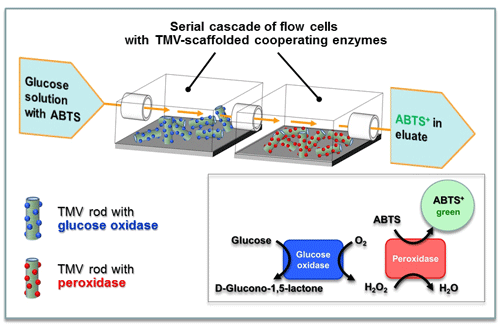The Research Network
Functional Nanostructures
was funded by the
Baden-Württemberg Stiftung.
The project focuses on design and fabrication of advanced multifunctional serial detection devices which benefit from stable, plant virus-derived carrier biotemplates: These allow both a high-density presentation of optimally accessible enzymatic sensing units and their site-specific integration in ‘systems-on-a-chip’. Serially addressable technical substrates, e.g. inside flow cell channels, will be equipped with multivalent tubular nanoparticles self-assembled from tobacco mosaic virus (TMV)-deduced building blocks to expose distinct biomolecule species on adjacent surface areas (see figure). Thereby, cooperating ligand molecules may be ordered into combinatorially active enzyme cascades with nanometric precision, advantageous for controlling reaction parameters and thus efficiency of the interacting ensembles. The technique will be optimized by use of a well-established analyte-detecting enzyme system. To reduce undesired cross-talk between the enzymatic players which can reduce array sensitivity, a serial placement of the active materials inside microfluidic systems will ensure local separation. Promising layouts will be tested for their performance with respect to e.g. biologically or environmentally relevant analytes and commercially applied multiplex detection technology.

TMV-supported serial biosensing: layout and functional principle in microfluidic device.